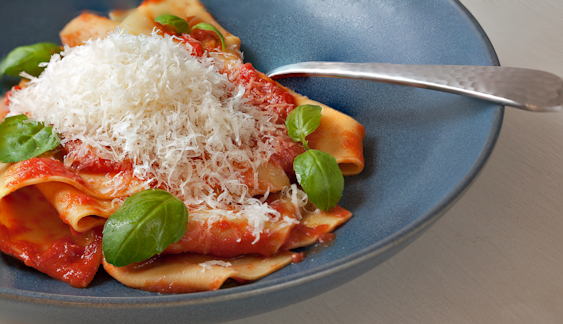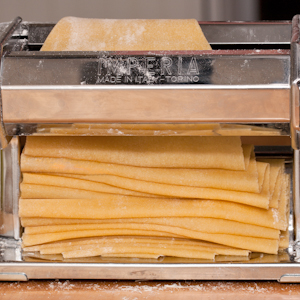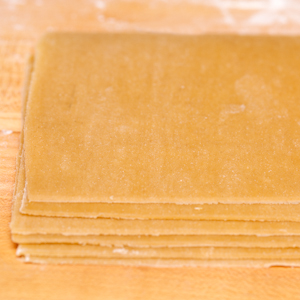Fazzoletti (Handkerchief Pasta) with Lickety-Quick Red Sauce

introduction
This is as easy and satisfying a homemade pasta dish as you’ll ever make or eat. The pasta itself has outstanding handling properties and cooks quickly without losing its bite. It is never tough, but also never mushy.
Cooking Remarks
No one can deny the simple appeal of pasta and red sauce. It is one of the greatest flavor and texture collaborations on earth. And for our money, nothing beats this Italian import as a quick, convenient tomato product: Bionaturae Organic Strained Tomatoes. These smooth-textured, jarred tomatoes taste fresh and bright—they contain neither sugar nor salt, nor stale dried herbs, nor searing garlic powder, and they obviate the need for hours of simmering on the stove or a full-on culinary intervention to make a tomato sauce that tastes absolutely terrific.
By the way, this pasta can be re-rolled for an increased yield, if you wish. Though re-rolled dough is inclined to become tough, we didn’t notice an appreciable change with a single re-roll.
equipment mise en place
For this recipe, you will need a 2-quart saucepan; a wooden spoon; a rimmed baking sheet; a pasta machine; a bench knife or chef’s knife; a rolling pin; a ruler; a large, deep braising or sauté pan; a colander; and a pair of tongs.
-
for the sauce:
-
1tablespoon olive oil
-
1garlic clove, minced
-
2cups Bionaturae Organic Strained Tomatoes
-
¼teaspoon red pepper flakes
-
½teaspoon fine sea salt
-
1tablespoon unsalted butter
-
-
for the pasta:
-
1tablespoon durum semolina
-
1recipe Fresh Sheet Pasta
-
Anson Mills Farina di Maccheroni ‘oo’ Crema, for rolling out the dough
-
Table salt
-
Vegetable oil spray
-
Grated Parmesan Reggiano for serving
-
-
Make the sauce: Heat the olive oil in a 2-quart saucepan over low heat. Add the garlic and stir it around in the oil until it's just fragrant, about 10 seconds. Add the tomatoes, pepper flakes, and salt. Bring to a simmer over medium heat and cook, stirring occasionally, until the flavors come together, 4 to 5 minutes. Cover the pan and set it aside off heat.
-
Roll out the fazzoletti: Sprinkle a rimmed baking sheet with the durum semolina and set it aside. Set up the pasta machine. Cut the pasta dough into 6 pieces with a bench knife or chef’s knife (fig. 2.1) and return 5 of the pieces to the zipper-lock bag. Lightly flour the sixth piece and, using a rolling pin, roll it out on a lightly floured work surface into a band about 4 inches long, 3 inches wide, and about ⅓ inch thick (fig. 2.2). Beginning with the widest setting and stopping after the penultimate setting, run the dough once through each setting of the pasta machine, flouring as needed. Pass the dough through the penultimate setting once more, for a total of two times (fig. 2.3). The band of dough will be about 20 inches long. Trim away the tapered ends with a bench knife and, using the bench knife and a ruler, trim the long edges to straighten them. Then, cut the dough band into 4-inch squares (fig. 2.4). Transfer the squares to the prepared baking sheet. Repeat with the remaining pieces of dough. You will end up with about 24 handkerchief squares of pasta.
-
Cook the fazzoletti: Fill a large, deep braising or sauté pan with water and bring the water to a boil over high heat. Add about 2 teaspoons of table salt for every 2 quarts of water, and then reduce the heat so that the water simmers. Using a skimmer, gently lower the fazzoletti into the water, adding six at a time (fig. 3.1). Simmer until the pasta is tender but still firm, about 2 minutes, turning once about halfway through. Drain in a colander.
-
Sauce the fazzoletti: While the fazzoletti cook, return the sauce to a simmer over medium heat. After draining the pasta, stir the butter into the sauce. Toss the pasta with the hot sauce, using a warmed bowl, and a pair of tongs. Taste for seasoning. Serve in warmed bowls with grated Parmesan Reggiano passed at the table.
-
-
2.1

-
2.2

-
2.3

-
2.4

-
-
-
3.1

-